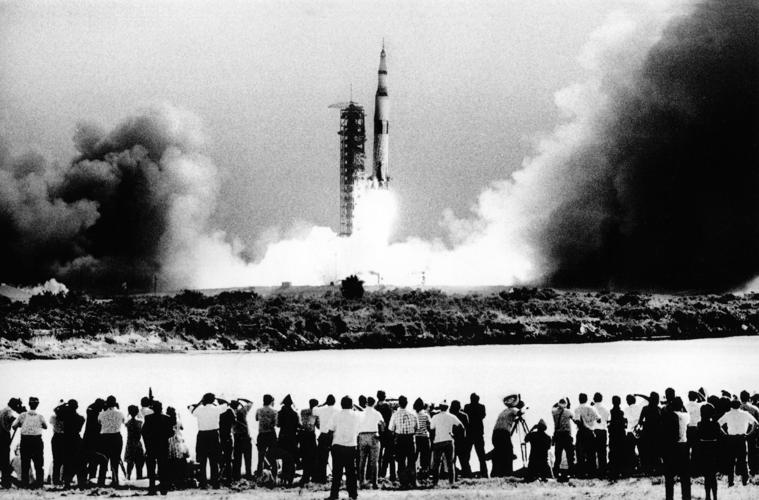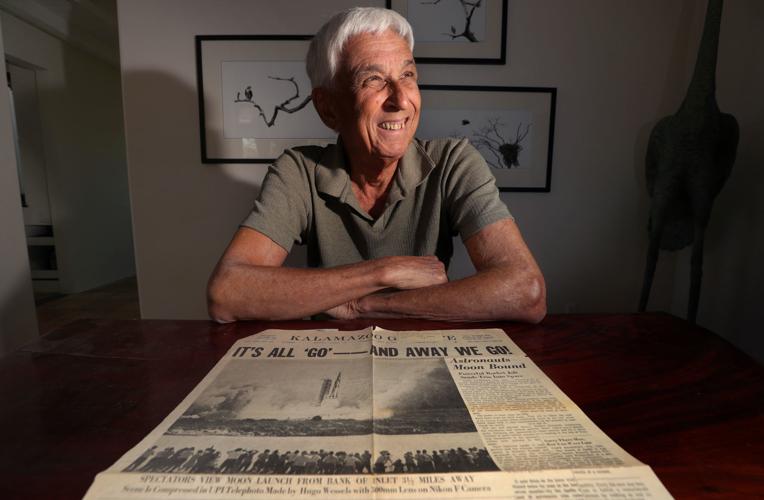On the morning of July 16, 1969, United Press International photographer Hugo Wessels woke up, grabbed his Nikon F camera and headed to Cape Kennedy, Florida.
His assignment? To capture the liftoff of Apollo 11, the mission that would land two men on the moon for the first time in history.
The assignment quickly turned into what Wessels, who now lives in Tucson, would describe as the highlight of his 25-year career with the news service. On that day, what he captured through his 300 mm lens — the spacecraft attached to a massive Saturn V rocket rising from the ground, white smoke billowing from underneath and a crowd of people watching from afar — became one of the most printed news photographs of its time.
Four days later, Wessels watched from his home in Miami as commander Neil Armstrong and lunar module pilot Buzz Aldrin took their first steps onto the moon’s surface.
“I was in bed watching it and I just started crying. I literally broke down,” Wessels said. “I think it was the moment he said, ‘The Eagle has landed,’ and tears just welled up in my eyes.”
This was the culmination of a decade of photojournalism for Wessels. He had been covering every major space event since President John F. Kennedy gave a historic speech to Congress in 1961 that set the United States on a course to the moon, from the first American to orbit the Earth to NASA’s Gemini mission, and finally, Apollo.
Now, 50 years later, the 81-year-old Tucson resident is reflecting on his connection to what he said was an unforgettable time in American history.
“It still feels wonderful to have been a part of it. I can’t believe it’s been 50 years,” he said. “I will always be proud of that moment.”
With four other UPI photographers, Wessels said that day at Cape Kennedy was unlike any other space mission he had covered before. People flocked to the scene and there were at least 500 other photographers from around the world there to try and get the same shot.
There were so many people, Wessels said, that in order to watch the astronauts walk from the operation building to the transport van, he and his boss actually had to crawl through people’s legs to get to the front of the crowd.
“My job was to get the first picture on the wire,” he said.
About seven hours after arriving at Cape Kennedy, it was time for liftoff. Up until this point, Wessels said, any photographer covering a rocket launch was using a 600 mm lens for a vertical shot of the spacecraft. This time, however, Wessels wanted to try something different. After developing photos from a backup camera, Wessels was inspired to do a horizontal shot with a wider view.
“I thought, ‘you know, I’d like to make that picture, but it needs space. That’s a six-column picture,’” he said. “Only Apollo 11 is going to demand that kind of space.”
So, as other photographers stood with tripods and cameras positioned vertically, Wessels dropped low to the ground with a 300 mm lens and took the shot, crowd and all.
Immediately after, Wessels took his camera to a nearby trailer, developed the film, made a print with a caption and sent it through the transmitter. The photo was in the hands of thousands of editors from around the world within 15 minutes.
“I was on cloud nine. When the initial reports came in from New York that this was being printed everywhere, I was so excited. Ironically, my accomplishment was quickly overshadowed by Neil Armstrong stepping onto the moon,” Wessels joked.
Wessels left UPI in 1984 and pursued his own wire service business. After 10 years, he and his wife decided to hit the road.
They traveled across North America in an RV for seven years before finding their “perfect desert oasis” in Tucson in 2002. Wessels still does photography today and particularly loves to capture images of nature.
Wessels, an immigrant from the South American nation of Suriname, never thought photography would become his passion.
After moving to New York City at 16, going to a public school in the Bronx and scraping by on “movie English, mostly Tarzan and cowboys,” Wessels’ father, who was still living in Suriname at the time, gave him a camera and told him to photograph everything.
Wessels had no idea that 15 years later he would document one of the most important days in history.
“We did it,” he said. “We got to the moon.”





